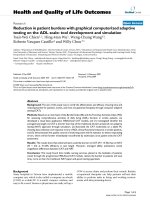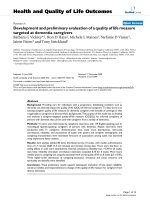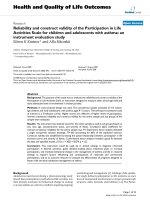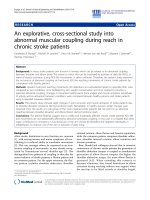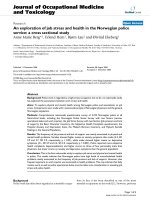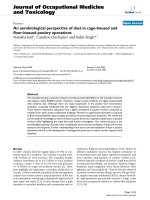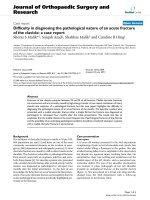báo cáo hóa học:" An in vivo evaluation of bone response to three implant surfaces using a rabbit intramedullary rod model" doc
Bạn đang xem bản rút gọn của tài liệu. Xem và tải ngay bản đầy đủ của tài liệu tại đây (1.78 MB, 8 trang )
RESEA R C H ART I C L E Open Access
An in vivo evaluation of bone response to three
implant surfaces using a rabbit intramedullary
rod model
Juan C Hermida
1
, Arnie Bergula
1
, Fred Dimaano
2
, Monica Hawkins
2
, Clifford W Colwell Jr
1
, Darryl D D’Lima
1*
Abstract
Our study was designed to evaluate osseointegration among implants with three surface treatments: plasma-
sprayed titanium (P), plasma-sprayed titanium with hydroxyapatite (PHA), and chemical-textured titaniu m with
hydroxyapatite (CHA). Average surface roughness (Ra) was 27 microns for the P group, 17 microns for the PHA
group, and 26 microns for the CHA group. Bilateral distal intramedullary implants were placed in the femora of
thirty rabbits. Histomorphometry of scanning electron microscopy images was used to analyze the amount of
bone around the implants at 6 and 12 weeks after implantation. Greater amounts of osseointegration were
observed in the hydroxyapatite-coated groups than in the noncoated group. For all implant surfaces, osseointegra-
tion was greater at the diaphyseal level compared to the metaphyseal level. No significant differences were seen in
osseointegration between the 6 and 12 week time points. Although the average surface roughness of the P and
the CHA groups was similar, osseointegration of the CHA implants was significantly greater. The results of this in
vivo lapine study suggest that the prese nce of an hydroxyapatite coating enhances osseointegration despite simila-
rities in average surface roughness.
Introduction
Total hip arthroplasty (THA) is a relatively common
procedure that typically results in increased comfort,
mobility, pain relief, and alleviation of disability. Once
thought to be appropriate for patients between 60 and
75 years of age, the age range for primary THA now
often includes a substantially younger population [1-4].
The procedure has an excellent clinical outcome and
often restores functional capacity to a large degree.
However, aseptic loosening of the components con-
tinues to limit the longevity of THA, especially in
younger more active patients [1-11]. With the increase
in life expectancy and the increase in younger patients
undergoing primary THA, the need to extend the long-
evity of THA is essential.
Non-cemented THA offers the potential for integra-
tion of the implant surface with the surrounding bo ne.
Hydroxyapatite coatings have proven effective in
providing excellent short- and intermediate-term out-
comes in terms of fixation, stability, function, and pain
relief [12-17]. H ydroxyapatite coatings enhance osteo-
blast attachment, prolife ration, and differentiation (see
Beck for review [18]). While hydroxyapatite is generally
considered to be an osteoconductive material, it has
occasionally been shown to have osteoinductive proper-
ties, which have been attributed to the adsorption of
bone morphogenetic proteins [19].
Osteoblastic activity is modulated by surf ace rough-
ness and is enhanced when the R
a
is between 1 and 7
μm [20,21]. In addition, surface roughness in vivo is an
important factor affecting bone apposition and mechani-
cal strength of the implant-bone interf ace. Increasing
surface roughness by grit-blasting or chemical-etching
has been associated with increased osseointegration in a
variety of animal models [22-25].
Since hydroxyapatite coating can alter surface rough-
ness, it is important to determine the relative significance
of the individual contributions of these factors [22,26]. For
example, superior osseointegration was found in hydro-
xyapatite-coa ted trabecul ar implants in miniature pigs
compared to grit-blasted or acid-etched surface [25].
* Correspondence:
1
Orthopaedic Research Laboratories, Shiley Center for Orthopaedic Research
and Education at Scripps Clinic, 11025 North Torrey Pines Road, Suite 140, La
Jolla, CA, 92037, USA
Full list of author information is available at the end of the article
Hermida et al. Journal of Orthopaedic Surgery and Research 2010, 5:57
/>© 2010 Hermida et al; license e B ioMed Central Ltd. This is an Open Access art icle distributed under the ter ms of the Creative
Commons Attribution Lice nse ( which permits unrestricted use, distribution, and
reproduction in any medium, provided the original work is properly cited.
However, the hydroxyapatite-coated implants had a signif-
icantly greater R
a
. It has not been conclusively shown
whether surface roughness or hydroxyapatite coating is
the dominant factor affecting in vivo osseointegration.
One study concluded that surface roughness contributed
more to increased bone apposition rates than hydroxyapa-
tite coating [26]. On the other hand another study found
significantly increased bone apposition in hydroxyapatite-
coated implants despite comparable surface roughness
measures between coated and uncoated implants [27]. We
therefore designed a study to investigate the factors contri-
buting to osseointe gration in orthopedically relevant sur-
faces. The study hypothesis was that the addition of a
hydroxyapatite coating would enhance osseointegration
beyond that provided by change in surface roughness
alone.
Methods
Implants for intramedullar y implantation in rab bit
femora were manufactured and sterilized by Stryker
Orthopaedics, Mahwah, NJ. Each implant consisted of a
cylinder 5 mm in diameter and 25 mm in length (Figure
1). One of three surface treatments was applied to each
implant: plasma-sprayed titanium (P), plasma-sprayed
titanium with hydroxyapatite (PHA), or chemical-tex-
tured titanium with hydroxyapatite (CHA). The hydro-
xyapatite coating was applied by plasma spraying high
purity hydroxyapatite powders with tightly controlled
particle size using Sulzer Metco Plasma Spray System.
HA powders were injected with Argon as the carrier gas
to produce coating with thickness ranging from 40-70
microns (nominal 50 microns). The coating had a mini-
mum total crystallinity of 65%. The minimum HA frac-
tioninthecrystallinephasewas90%.Theaverage
tensile and sh ear strength of the coating were ≥ 34 MPa
and ≥17 MPa respectively. The c hemical texturing was
performed by repetitive masking (with an acid resistant
mask) and chemical milling with nitric and hydrofluoric
acid. The details regarding the chemical texturing pro-
cess and the osseointegration of chemical-textured
implants have been previously reported [22]. Implant
surface roughness was meas ured with a Sheffield Profil-
ometer (Sheffield, Fond du Lac, WI).
Thirty adult male New Zealand White rabbits were
used in our study. After institutional review board
approval, rabbits underwent bilateral femoral intrame-
dullary implantation under general anesthesia. All ani-
mals received Buprenorphine 0.03 mg/Kg IM
immediately postoperatively, and 0.01 mg/Kg IM every
12 hours for three days. After that any animal demon-
strating pain or discomfort received Buprenorphine
0.01 mg/Kg IM. All animals were allowed unrestricted
cage activity, and food and water ad libitum. Tempera-
ture was maintained at 24°C and humidity at 70%. All
rabbits tolerated the anesthesia and surgical procedure
uneventfully. Recovery was quick and rabbits were
usually ambulating without noticeable limp by post-
operative day 7. One rabbit developed intestinal
obstruction after ingesting surgical dressing and was
euthanized 6 days before schedule. The femora were
harvested from this rabbit a nd included in the SEM
analysis.
The details of this in vivo rabbit model have been
described previously (Figure 2) [22,28]. The appropriate
experimental implant was press-fit into the intramedul-
lary canal through a drill hole in the intercondylar
notch of the femur. Bilateral implantatio n was used to
reduce any bias introduced by unilateral implantation
because the animal might favor the operated limb.
Implants were distributed by type between limbs to per-
mit paired comparison with an equal number of pairs
per time point (P vs PHA, P vs CHA, and PHA vs
CHA). Fifteen rabbits were euthanized postoperatively at
6weeks;15at12weeks.Ateuthanasia, bilateral distal
femora were harvested, cleaned of soft tissue, and fixed
in 70% ethanol.
The femur bone was trimmed above and below the ends
of the implant, cleaned of soft-tissue, and fixe d in 70%
alcohol. The specimen was further dehydrated in absolute
alcohol and de-fatted in 50% mixture of ether and acetone
before being placed in 100% alcohol again for 12 hours.
Figure 1 Photographs of implant surfaces. P = plasma-sprayed
titanium (mean R
a
= 27 microns); PHA = plasma-sprayed titanium
with plasma-sprayed hydroxyapatite coating (mean R
a
=17
microns); CHA = chemical-textured titanium surface (by acid
etching) with hydroxyapatite coating (mean R
a
= 26 microns). On
visual inspection the surface texture of the P surface appear
qualitatively more similar to the PHA surface when compared to the
CHA surface.
Hermida et al. Journal of Orthopaedic Surgery and Research 2010, 5:57
/>Page 2 of 8
The specimen was then embedded in methyl methacrylate
and transverse sections nominally 1-mm thick cut with a
diamond wafering blade at three levels, approximately
coinciding with the distal third of the femoral diaphysis,
the distal femoral metaphysis, and a level midway between
the two. Backscatter electron images were obtained using
a scanning electron microscope (JEOL 35, JEOL Ltd,
Tokyo, Japan) at 4 0 × m agnifications, 25-KeV beam vol -
tage, and 100 μA emission current at a working distance
of 15 mm. Images were of the implant-bone interface
were captured around the perimeter of the implant and
stored in 8-bit grayscale format at a resolution of 128 pix-
els per mm (pixel size 7.8 μm).
Automated computerized image analysis was per-
formed on the SEM images using a previously validat ed
approach [22,29]. A custom script was written
(MATLAB, Image Processing To olbox, MathWorks,
Natick, MA). The image was segmented into bone and
implant regions based on the trimodal histogram of the
image. Images were initially filtered to remove random
stray pixels. The image w as segmented into three areas
represented by: implant pixels (grayscale value between
200 and 255), bone pixels (grayscale value between 80
and 200), and soft-tissue pixels (grayscale value between
0 and 80). An edge detection algorithm was used to
detect pixels at the perimeter of the implant and the
bone and soft-tissue pixels adjacent to the edge of the
implants were counted.
Osseointegration was de fined as bone-to-imp lant con-
tact and calculated as the ratio of the number of bone
pixels relative to the total number of pixels (bone + soft
tissue) at the perimeter of the implant. Additionally, the
relative numbers of bone pixels were measured at vary-
ing distances (up to 0.24 mm) radially outward from the
perimeter of the implant to detect changes in patterns
of bone growth among the different surfaces.
Power analysis determined that a sample size of 10
was adequate to detect differences in osseointegration of
greater than 15% among groups with a power greater
than 80% and an alpha of 0.05, assuming a standard
deviation of up to 11%. Results from four quadrants
were averaged to obtain the net osseointegration and
presence of bone for each section level.
Multifactorial two-way Analyses of Variance
(ANOVA) were performed on mean osseointegration
(or presence of bone at 0.03 to 0.24 mm from the
implant surface) with surface treatment, time after sur-
gery, and bone section level as the variables. When sta-
tistical differences were identified, Tukey post hoc
pairwise comparisons were performe d. Significant differ-
ences were assumed at p ≤ 0.05.
Results
Mean surface roughness (R
a
) was 27 microns for the P
group, 17 micro ns for the PHA group, and 26 microns
for the CHA group (statisti cally different between the P
and PHA groups and between the P and CHA groups).
Representative SEM images of o sseointegrat ion for the
three surfaces are shown in Figure 3. ANOVA indicated
significant differences in osse ointegratio n as a function
of both section level and surface treatment. Mean
osseointegration was significantly higher in the CHA (74
± 15%) and PHA (64 ± 14%) groups as compared to the
P group (39 ± 17%) (Figure 4). When all implant sur-
faces were pooled together, osseointegration at the dia-
physeal level (69 ± 18%) was significantly greater than at
both the intermediate (53 ± 22%) and metaphyseal levels
(56 ± 19%). However, the differences in osseointegration
along the axial direction were statistically similar
between surface treatments (i.e., diaphyseal osseointegra-
tion was greater for all implant surfaces). No significant
differences between 6 week and 12 week data were
observed (Figure 5).
ANOVA also indicated significant differences in pre-
senceofboneradiallyoutwardfromtheperimeterof
the implant. These differences were also related to both
section level and surface treatment, with no time effect.
Significantly greater bone was present w ithin 0.03 mm
of the implant surface was observed in the hydroxyapa-
tite-coated groups (Figure 6). However, from 0.03 to
0.24 mm no further differences in presence of bone
were noted as a function of surface treatment. Signifi-
cant differences in presence of bone among bone section
levels were also observed and these differences remained
constant throughout the 0.24 mm distance from the
implant perimeter evaluated. The presence of bone in
Figure 2 Diagram of intramedullary implantation. The implanted
bone was sectioned at three levels shown.
Hermida et al. Journal of Orthopaedic Surgery and Research 2010, 5:57
/>Page 3 of 8
Figure 3 Representative SEM images are shown depicting the r ange of low and high osseointegration for each s urface. A:Plasma-
sprayed titanium surface (P) showing 0% osseointegration (intermediate level, posterior quadrant). B: Plasma-sprayed titanium surface (P)
showing 46% osseointegration (diaphyseal level, anterior quadrant). C: Plasma-sprayed titanium surface with hydroxyapatite (PHA) coating
showing 11% osseointegration (intermediate level, anterior quadrant). D: Plasma-sprayed titanium surface with hydroxyapatite (PHA) coating
showing 100% osseointegration (diaphyseal level, anterior quadrant). E: Chemical-textured surface with hydroxyapatite coating (CHA) showing
24% osseointegration (intermediate level, anterior quadrant). F: Chemical-textured surface with hydroxyapatite coating (CHA) showing 97%
osseointegration (diaphyseal level, anterior quadrant). The bar represents 1 mm (image resolution = 280 pixels per mm).
Hermida et al. Journal of Orthopaedic Surgery and Research 2010, 5:57
/>Page 4 of 8
the radial direction at the diaphyseal and metaphyseal
levels was significantly higher than at the intermediate
level. No significant differences in presence of bone
were observed between 6 and 12 weeks.
Discussion
The intramedullary bone response to three titanium
surfaces (grit-blasted, porous fiber mesh, and acid-
etched) was previously evaluated using the same ani-
mal model [22]. In that study, the chemically textured
(by acid-etching) surface with a R
a
of 18 microns
showed higher osseointegration than the grit-blasted
surface with and R
a
of 6 microns. This study builds on
our previous findings by investigating the effect of
hydroxyapatite coating on surfaces with different
roughness. The PHA and CHA groups had very differ-
ent R
a
values of 17 microns and 26 microns, respec-
tively, yet the osseointegration of each hydroxyapatite-
coated surface was comparable, which suggested that
the presence of the osteoinductive hydroxyapatite
coating had a greater influence on bone growth than
the surface roughness. Conversely, the mean R
a
values
for the P and CHA groups were very similar at 27
microns and 26 microns, respectively. However, the
osseointegration and distribution of bone were signifi-
cantly different between these two groups.
Both surface roughness and hydroxyapatite coating
have been shown to increase osseointegration [30].
Some reports have attributed increased osseointegration
to surface roughness [23,31,32] while other reports to
the hydroxyapatite coating [33-36]. Since the hydroxya-
patite coating alters the surface roughness, a few studies
have attempted to quantify the relative contribution of
surface topography versus hydroxyapatite coating. Carls-
son et al implanted titanium implants in the upper tibia
of osteoarthritic knees of patients scheduled for total
knee arthroplasty [37]. The osseointegr ation reported at
3 months was significantly higher in grit-blasted
implants (mean R
a
= 3.1) than in implants with a
smooth surface (mean R
a
= 0.9). This osseointegration
was similar to that seen in implants coated with hydro-
xyapatite (mean R
a
= 5.1). However, the sample size stu-
died was small with a large variance in the reported
data. In a more controlled canine femoral intramedul-
lary model, Hacking et al determined the relative contri-
butions of surface chemistry and topography on
Figure 4 Mean osse ointegration (with standard deviation bars)
was plotted for each paired comparison.Datafrom6and12week
time points were pooled. The hydroxyapatite-coated groups (PHA and
CHA) consistently resulted in higher levels of osseointegration than in
the uncoated group. The difference between the two hydroxyapatite-
coated groups was not significant. (P = plasma-sprayed titanium;
PHA = plasma-sprayed titanium with hydroxyapatite coating, and
CHA = chemical-textured titanium with hydroxyapatite; * denotes
statistically significant difference at p < 0.05).
Figure 5 Mean osseointegration (with standard deviation bars)
was plotted for each group at the 6-week and 12-week time
points. No significant differences between time points were noted.
Figure 6 Percentage of bone plotted as a function of distance
from implant surface. Six and 12 week data are pooled for each
group. Bone growth was higher within 0.03 mm of the implant
surface in the hydroxyapatite-coated groups compared to the
uncoated group.
Hermida et al. Journal of Orthopaedic Surgery and Research 2010, 5:57
/>Page 5 of 8
osseoi ntegration [26]. The hydroxyapatite surface of one
group of implants was coate d with a thin film of tita-
nium, which masked the chemical activity of the hydro-
xyapatite coat while retaining the topography and
surface roughness. Mean osseointegration of hydroxya-
patite-coated implants (74%) was h igher than the
masked hydroxyapatite group (59%) or the grit-blasted
group (23%). The relative increase in osseointegration
between masked hydroxyapatite implants and grit-
blasted implants was larger than the increase in osseoin-
tegration between hydroxyapatite-coated and masked
hydroxyapatite implants. The authors therefore con-
cluded that surface topography was the dominant factor
influencing bone growth.
On the other hand, our study found a stronger corre-
lation between the presence of hydroxyapatite and
osseointegration than between surface roughness and
osseointegration. In o ur study, the surface roughness of
the implants used ranged from a R
a
of 17 to 26 microns.
The surface roughness of the implants tested by Carls-
son et al and Hacking et al were in the 3 to 6 micron
range. It is therefore possible that an interaction effect
exists between surface roughness and hydroxyapatite
coating on osseointegration. At higher magnitudes of
surface roughness, the hydroxyapatite coating may con-
tribute more to osseointegration. The differences in
findings underscore the need for additional research to
better understand the processes that influence
osseointegration.
Osseointegration was significantly higher at the dia-
physeal level compared to that at the metaphyseal or
intermediate levels. Implant-bone contact as well the
type of bone (trabecular ve rsus lamellar) varies along
the axial direction. However, the differences in osseoin-
tegration along the axial direction were statistically simi-
lar between surface treatments. This suggests an
absence of interaction effect between surface chemistry
and location of implant. The presence of bone in the
radial direction also v aried by implant surface. Signifi-
cantly greater bone was present within 0.03 mm o f the
implant surface in the hydroxyapatite-coated groups.
While the SEM could not differentiate between newly
deposited bone and pre-existing bone, these differences
near the implant-bone surface were likely due to new
bone formation.
The similarity in the chemistry of the hydroxyapatite
coating with the crystalline phase of bone is believed to
be one of the reasons for its excellent biocompatibility
and osteoconductive properties. The slow b ut finite dis-
solution rate of crystalline hydroxyapatite provides a
continuous source of calcium and inorganic phosphate
[18]. In our present study, as well as in those reported
by others, bone often appears to be directly deposited
on the h ydroxyapatite coating without any intervening
layer of fibrous tissue, the latter being more commonly
seen in uncoated titanium surfaces [22,23,28,37]. While
hydroxyapatite by itself is considered osteoconductive,
in vivo the surface adsorption of proteins (such as bone
morphogenetic proteins) may render the surface
osteoinductive [38,39]. In addition, osteoblasts may
attach and release active osteoinductive factors[18]. All
of these factors combined may be responsible for the
enhanced bone response.
Clinical outcomes have substantiated the results of
this animal model. Early osseointegration and more
stable implant-bone interfaces were seen radiographi-
cally. In patients implanted w ith hydroxyapatite-co ated
femoral stems, no evidence of mechanical failures or
progressive radiolucencies was noted [40,41]. Evidence
exists that hydroxyapatite provides benefit s beyond pro-
moting osseointegration and enhancing implant stability.
More complete osseointegration may act as a barrier to
the migration of polyethylene debris along the bone-
implant interface thereby reducing the incidence of
osteolysis [9,10,42,43]. Rahbek et al demonstrated that
hydroxyapatite effectively prevented particle migration
when compared to non-coated grit-blasted titanium
alloy implants in a canine femoral model [10,43 ,44]. A
ten-year clinical follow up of a hydroxyapatite-coated
femoral stem did not find evidence of distal osteolysis
despite relatively high polyethylene wear [41,45]. With
current-generation implant designs, short-term stability
is no longer a major issue [14,15,46,47]. Longer-term
follow up, however, shows polyethylene wear and lysis
to be a maj or concern [48-51]. Measures that directly
reduce wear (such as crosslinked polyethylenes and
alternative bearing surfaces) have been introduced with
some success [52,53]. However, a higher level of
osseointegration is also extremely valuable, because it
can reduce the incidence of distal osteolysis, which is
one of the primary causes of implant failure [41,48,54].
One limitation of the study was the use of only rough-
ness parameter (R
a
). Other roughness and surface para-
meters may also be important in determining potential
for osseointegration. Osseointegration was only mea-
sured using one histomorphometric parameter (bone-to-
implant contact). We did not measure the mechanical
strength of the interface that is relevant for hip arthro-
plasty. However, others have correlated mechanical pull-
out strength with the histomorphetric assessment of
osseointegration [28].
Effective osseointegration of noncemented compo-
nents plays an essential role in implant fixation, long-
term stability, and survivorship. Our in vivo study evalu-
ate d the bone response to three surfaces, which adds to
the body of evidence that is useful for optimizing the
osseointegration of implants and enhancing fixation. It
is important to identify factors that minimize joint
Hermida et al. Journal of Orthopaedic Surgery and Research 2010, 5:57
/>Page 6 of 8
arthroplasty failure and the significant physical and
financial costs that failure represents. Finally, clinical
outcomes studies are needed to validate the impact of
implant surface and related osseointegration on THA
outcomes.
Author details
1
Orthopaedic Research Laboratories, Shiley Center for Orthopaedic Research
and Education at Scripps Clinic, 11025 North Torrey Pines Road, Suite 140, La
Jolla, CA, 92037, USA.
2
Stryker Orthopaedics, 300 Commerce Court, Mahwah,
NJ 07430, USA.
Authors’ contributions
DDD, CWC, MH contributed to the conception and the study design. JCH,
AB, MR participated in the data acquisition. DD and FD performe d the data
verification. FD, MH, CWC, DDD were involved in the data interpretation.
JCH, MH, DDD contributed to the writing of the manuscript. All authors
have read and approved the final manuscript.
Competing interests
Research funds in support of this study were provided to Scripps Clinic from
Stryker Orthopaedics. Two of the authors are employees of Stryker
Orthopaedics.
Received: 27 January 2010 Accepted: 16 August 2010
Published: 16 August 2010
References
1. Chmell MJ, Scott RD, Thomas WH, Sledge CB: Total hip arthroplasty with
cement for juvenile rheumatoid arthritis. Results at a minimum of ten
years in patients less than thirty years old. J Bone Joint Surg Am 1997,
79:44-52.
2. Garino JP, Steinberg ME: Total hip arthroplasty in patients with avascular
necrosis of the femoral head: a 2- to 10-year follow-up. Clin Orthop Relat
Res 1997, 334:108-115.
3. Malchau H, Wang YX, Karrholm J, Herberts P: Scandinavian multicenter
porous coated anatomic total hip arthroplasty study. Clinical and
radiographic results with 7- to 10-year follow-up evaluation. J
Arthroplasty 1997, 12:133-148.
4. Torchia ME, Klassen RA, Bianco AJ: Total hip arthroplasty with cement in
patients less than twenty years old. Long-term results. J Bone Joint Surg
Am 1996, 78:995-1003.
5. Berry DJ, Harmsen WS, Ilstrup D, Lewallen DG, Cabanela ME: Survivorship
of uncemented proximally porous-coated femoral components. Clin
Orthop Relat Res 1995, 319:168-177.
6. Callaghan JJ, Tooma GS, Olejniczak JP, Goetz DD, Johnston RC: Primary
hybrid total hip arthroplasty: an interim followup. Clin Orthop Relat Res
1996, 333:118-125.
7. D’Lima DD, Oishi CS, Petersilge WJ, Colwell CW Jr, Walker RH: 100
cemented versus 100 noncemented stems with comparison of 25
matched pairs. Clin Orthop Relat Res 1998, 348:140-148.
8. Dickob M, Martini T: The cementless PM hip arthroplasty. Four-to-seven-
year results. J Bone Joint Surg Br 1996, 78:195-199.
9. Engh CA Jr, Culpepper WJ, Engh CA: Long-term results of use of the
anatomic medullary locking prosthesis in total hip arthroplasty. J Bone
Joint Surg Am , 2 1997, 79:177-184.
10. Petersilge WJ, D’Lima DD, Walker RH, Colwell CW Jr: Prospective study of
100 consecutive Harris-Galante porous total hip arthroplasties. 4- to 8-
year follow-up study. J Arthroplasty 1997, 12:185-193.
11. Stulberg BN, Singer R, Goldner J, Stulberg J: Uncemented total hip
arthroplasty in osteonecrosis: a 2- to 10-year evaluation. Clin Orthop Relat
Res 1997, 334:116-123.
12. D’Antonio JA, Capello WN, Crothers OD, Jaffe WL, Manley MT: Early clinical
experience with hydroxyapatite-coated femoral implants. J Bone Joint
Surg Am 1992, 74:995-1008.
13. D’Antonio JA, Capello WN, Manley MT:
Remodeling of bone around
hydroxyapatite-coated femoral stems. J Bone Joint Surg Am 1996,
78:1226-1234.
14. D’Lima DD, Walker RH, Colwell CW Jr: Omnifit-HA stem in total hip
arthroplasty. A 2- to 5-year followup. Clin Orthop Relat Res 1999,
363:163-169.
15. Geesink RG, Hoefnagels NH: Six-year results of hydroxyapatite-coated
total hip replacement. J Bone Joint Surg Br 1995, 77:534-547.
16. Harris WH: The problem is osteolysis. Clin Orthop Relat Res 1995, 311:46-53.
17. Kroon PO, Freeman MA: Hydroxyapatite coating of hip prostheses. Effect
on migration into the femur. J Bone Joint Surg Br 1992, 74:518-522.
18. Beck GR Jr: Inorganic phosphate as a signaling molecule in osteoblast
differentiation. J Cell Biochem 2003, 90:234-243.
19. Reddi AH: Morphogenesis and tissue engineering of bone and cartilage:
inductive signals, stem cells, and biomimetic biomaterials. Tissue Eng
2000, 6:351-359.
20. Michaels CM, Keller JC, Stanford CM, Solursh M: In vitro cell attachment of
osteoblast-like cells to titanium. J Dental Res 1989, 68:276-282.
21. Curtis A, Clark P: The effects of topographical and mechanical properties
of materials on cell behavior. CRC Crit Rev Biocompatibil 1990, 5:343-362.
22. D’Lima DD, Lemperle SM, Chen PC, Holmes RE, Colwell CW Jr: Bone
response to implant surface morphology. J Arthroplasty 1998, 13:928-934.
23. Feighan JE, Goldberg VM, Davy D, Parr JA, Stevenson S: The influence of
surface-blasting on the incorporation of titanium-alloy implants in a
rabbit intramedullary model. J Bone Joint Surg Am 1995, 77:1380-1395.
24. Wennerberg A, Albrektsson T, Johansson C, Andersson B: Experimental
study of turned and grit-blasted screw-shaped implants with special
emphasis on effects of blasting material and surface topography.
Biomaterials 1996, 17:15-22.
25. Wong M, Eulenberger J, Schenk R, Hunziker E: Effect of surface topology
on the osseointegration of implant materials in trabecular bone. J
Biomed Mater Res 1995, 29:1567-1575.
26. Hacking SA, Tanzer M, Harvey EJ, Krygier JJ, Bobyn JD: Relative
contributions of chemistry and topography to the osseointegration of
hydroxyapatite coatings. Clin Orthop Relat Res 2002,
405:24-38.
27. Daugaard H, Elmengaard B, Bechtold JE, Jensen T, Soballe K: The effect on
bone growth enhancement of implant coatings with hydroxyapatite and
collagen deposited electrochemically and by plasma spray. J Biomed
Mater Res A 2010, 92:913-921.
28. Tisdel CL, Goldberg VM, Parr JA, Bensusan JS, Staikoff LS, Stevenson S: The
influence of a hydroxyapatite and tricalcium-phosphate coating on bone
growth into titanium fiber-metal implants. J Bone Joint Surg Am 1994,
76:159-171.
29. Holmes RE, Hagler HK, Coletta CA: Thick-section histometry of porous
hydroxyapatite implants using backscattered electron imaging. J Biomed
Mater Res 1987, 21:731-739.
30. Buser D, Schenk RK, Steinemann S, Fiorellini JP, Fox CH, Stich H: Influence
of surface characteristics on bone integration of titanium implants. A
histomorphometric study in miniature pigs. J Biomed Mater Res 1991,
25:889-902.
31. Gotfredsen K, Berglundh T, Lindhe J: Anchorage of titanium implants with
different surface characteristics: an experimental study in rabbits. Clin
Implant Dent Relat Res 2000, 2:120-128.
32. Gotfredsen K, Wennerberg A, Johansson C, Skovgaard LT, Hjorting-
Hansen E: Anchorage of TiO2-blasted, HA-coated, and machined
implants: an experimental study with rabbits. J Biomed Mater Res 1995,
29:1223-1231.
33. Darimont GL, Cloots R, Heinen E, Seidel L, Legrand R: In vivo behaviour of
hydroxyapatite coatings on titanium implants: a quantitative study in
the rabbit. Biomaterials 2002, 23:2569-2575.
34. Gottlander M, Albrektsson T, Carlsson LV: A histomorphometric study of
unthreaded hydroxyapatite-coated and titanium-coated implants in
rabbit bone. Int J Oral Maxillofac Implants 1992, 7:485-490.
35. Soballe K: Hydroxyapatite ceramic coating for bone implant fixation.
Mechanical and histological studies in dogs. Acta Orthop Scand Suppl
1993, 255:1-58.
36. Thomas KA, Kay JF, Cook SD, Jarcho M: The effect of surface macrotexture
and hydroxylapatite coating on the mechanical strengths and histologic
profiles of titanium implant materials. J Biomed Mater Res 1987,
21:1395-1414.
37. Carlsson L, Regner L, Johansson C, Gottlander M, Herberts P: Bone
response to hydroxyapatite-coated and commercially pure titanium
implants in the human arthritic knee. J Orthop Res 1994, 12:274-285.
Hermida et al. Journal of Orthopaedic Surgery and Research 2010, 5:57
/>Page 7 of 8
38. Dong X, Wang Q, Wu T, Pan H: Understanding adsorption-desorption
dynamics of BMP-2 on hydroxyapatite (001) surface. Biophys J 2007,
93:750-759.
39. Autefage H, Briand-Mesange F, Cazalbou S, Drouet C, Fourmy D,
Goncalves S, Salles JP, Combes C, Swider P, Rey C: Adsorption and release
of BMP-2 on nanocrystalline apatite-coated and uncoated
hydroxyapatite/beta-tricalcium phosphate porous ceramics. J Biomed
Mater Res B Appl Biomater 2009, 91:706-715.
40. Hermida JC, Patil S, Colwell CW Jr, D’Lima DD: Bioceramic-implant
coatings: correlation between animal and clinical studies. AAOS 72nd
Annual Meeting 2005, 6.
41. Lee GY, Srivastava A, D’Lima DD, Pulido PA, Colwell CW Jr: Hydroxyapatite-
coated femoral stem survivorship at 10 years. J Arthroplasty 2005,
20:57-62.
42. Bobyn JD, Jacobs JJ, Tanzer M, Urban RM, Aribindi R, Sumner DR,
Turner TM, Brooks CE: The susceptibility of smooth implant surfaces to
periimplant fibrosis and migration of polyethylene wear debris. Clin
Orthop Relat Res 1995, 311:21-39.
43. McPherson EJ, Dorr LD, Gruen TA, Saberi MT: Hydroxyapatite-coated
proximal ingrowth femoral stems. A matched pair control study. Clin
Orthop Relat Res 1995, 315:223-230.
44. Rahbek O, Overgaard S, Lind M, Bendix K, Bunger C, Soballe K: Sealing
effect of hydroxyapatite coating on peri-implant migration of particles.
An experimental study in dogs. J Bone Joint Surg Br 2001, 83:441-447.
45. D’Antonio JA, Capello WN, Manley MT, Geesink R: Hydroxyapatite femoral
stems for total hip arthroplasty: 10- to 13-year followup. Clin Orthop Relat
Res 2001, 393:101-111.
46. Capello WN: Hydroxyapatite in total hip arthroplasty: five-year clinical
experience. Orthopedics 1994, 17:781-792.
47. Capello WN, D’Antonio JS, Feinberg JR: Hydroxyapatite-coated stems in
patients under 50 years old: clinical radiographic results at five-year
minimum follow-up. Orthop Trans 1995, 19:399.
48. Capello WN, D’Antonio JA, Feinberg JR, Manley MT: Ten-year results with
hydroxyapatite-coated total hip femoral components in patients less
than fifty years old. A concise follow-up of a previous report. J Bone Joint
Surg Am 2003, 85-A:885-889.
49. Herrera A, Canales V, Anderson J, Garcia-Araujo C, Murcia-Mazon A,
Tonino AJ: Seven to 10 years followup of an anatomic hip prosthesis: an
international study. Clin Orthop Relat Res
2004, 423:129-137.
50. Reikeras O, Gunderson RB: Excellent results of HA coating on a grit-
blasted stem: 245 patients followed for 8-12 years. Acta Orthop Scand
2003, 74:140-145.
51. Rokkum M, Brandt M, Bye K, Hetland KR, Waage S, Reigstad R: Polyethylene
wear, osteolysis and acetabular loosening with an HA-coated hip
prosthesis. A follow-up of 94 consecutive arthroplasties. J Bone Joint Surg
Br 1999, 81:582-589.
52. Digas G, Karrholm J, Thanner J, Malchau H, Herberts P: The Otto Aufranc
Award. Highly cross-linked polyethylene in total hip arthroplasty:
randomized evaluation of penetration rate in cemented and
uncemented sockets using radiostereometric analysis. Clin Orthop Relat
Res 2004, 429:6-16.
53. Muratoglu OK, Bragdon CR, O’Connor DO, Jasty M, Harris WH: A novel
method of cross-linking ultra-high-molecular-weight polyethylene to
improve wear, reduce oxidation, and retain mechanical properties.
Recipient of the 1999 HAP Paul Award. J Arthroplasty 2001, 16:149-160.
54. Geesink RG: Osteoconductive coatings for total joint arthroplasty. Clin
Orthop Relat Res 2002, 395:53-65.
doi:10.1186/1749-799X-5-57
Cite this article as: Hermida et al.: An in vivo evaluation of bone
response to three implant surfaces using a rabbit intramedullary rod
model. Journal of Orthopaedic Surgery and Research 2010 5:57.
Submit your next manuscript to BioMed Central
and take full advantage of:
• Convenient online submission
• Thorough peer review
• No space constraints or color figure charges
• Immediate publication on acceptance
• Inclusion in PubMed, CAS, Scopus and Google Scholar
• Research which is freely available for redistribution
Submit your manuscript at
www.biomedcentral.com/submit
Hermida et al. Journal of Orthopaedic Surgery and Research 2010, 5:57
/>Page 8 of 8

